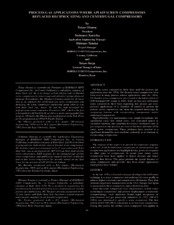| dc.contributor.other | Turbomachinery Symposium (35th : 2006) | |
| dc.creator | Ohama, Takao | |
| dc.creator | Koga, Takao | |
| dc.creator | Kurioka, Yoshinori | |
| dc.creator | Tanaka, Hironao | |
| dc.date.accessioned | 2017-10-04T22:49:07Z | |
| dc.date.available | 2017-10-04T22:49:07Z | |
| dc.date.issued | 2006 | |
| dc.identifier.uri | https://hdl.handle.net/1969.1/163186 | |
| dc.description | Lecture | en |
| dc.description | Pg. 89-96 | en |
| dc.description.abstract | Oil-free screw compressors have been used for process gas application since the 1970s. Oil-flooded screw compressors have been used in many process related application since the 1980s. Oil-flooded screw compressors are covered in the latest edition of API Standard 619 issued in 2004. Both oil-free and oil-flooded screw compressors have been expanding into process gas compression applications. It is therefore of interest to present the authors’ recent experiences and share the acquired knowledge by comparing features with reciprocating compressors and/or centrifugal compressors. High reliability, low maintenance costs, simple foundations, low operational costs, low initial consts, low consumed power at unloaded condition, and suitability for process fluctuation such as gas composition and pressure are some of the basic attributes of the rotary screw compressors. These attributes have resulted in a significant demand for such machine, primarily as an alternate to reciprocating compressors. | en |
| dc.format.medium | Electronic | en |
| dc.format.mimetype | application/pdf | |
| dc.language.iso | en | |
| dc.publisher | Texas A&M University. Turbomachinery Laboratories | |
| dc.relation.ispartof | Proceedings of the 35th Turbomachinery Symposium | en |
| dc.subject.lcsh | Turbomachines | en |
| dc.title | Process Gas Applications Where API 619 Screw Compressors Replaced Reciprocating And Centrifugal Compressors. | en |
| dc.type.genre | Presentation | en |
| dc.type.material | Text | en |
| dc.identifier.doi | https://doi.org/10.21423/R1X65M | |


